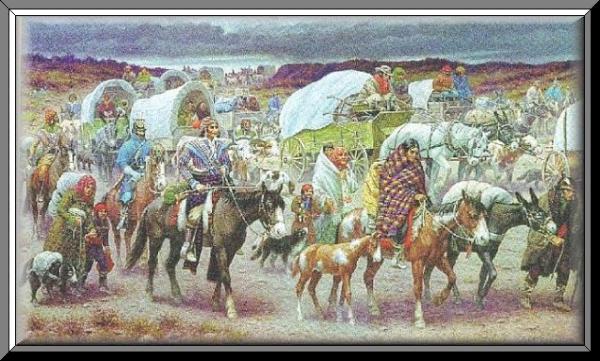'The Trail of Tears' 1838-39
The Death of the Cherokee Nation
White men in the 'New World' 1493:
"On November 14, 1493, Columbus made his first visit to "Ayay" (as the Indians called St. Croix) and renamed it Santa Cruz. His reception by the Caribs gives testament to their violent character. Upon anchoring at Salt River, a small boatload of Spaniards approached the shore and encountered a small canoe carrying four men and two women. A battle ensued, which resulted from the Spaniards attempting to capture the natives. One Carib and one Spaniard were killed. The remaining Caribs were taken prisoners. This was the early beginning of what would soon be widely employed; slavery. In response to such conflicts, Charles V of Spain declared that all Indians in the islands were enemies and should be eliminated." (source)
White men in the 'New World' 1838-1839:
"In the fall of 1838, over 16,000 Cherokee men, women, and children were force marched 800 miles from Georgia to unfamiliar lands in Oklahoma. Exposed to drought, disease, frigid weather, and provided with little clothing, shelter, or food, over 4,000 Cherokee Indians died. The paths that the Cherokee trudged over became known as the Trail of Tears." (Thomas V. Ress)
The Background:
In 1830 Congress passed the Indian Removal Act, providing funds to transport the eastern tribes beyond the Mississippi. In 1834 a special Indian territory was set up in what is now Oklahoma. In all, the tribes signed 94 treaties during Jackson's two terms, ceding millions of hectares to the federal government and removing dozens of tribes from their ancestral homelands.
Perhaps the most tragic chapter in this unfortunate history concerned the Cherokees, whose lands in western North Carolina and Georgia had been guaranteed by treaty since 1791. Among the most progressive of the eastern tribes, the Cherokees' fate was sealed when gold was discovered on their land in 1829. Even a favorable ruling from the Supreme Court proved little help. With the acquiescence of the Jackson administration, the Cherokees were forced to make the long and cruel trek to Oklahoma in 1835. Many died of disease and privation in what became known as the "Trail of Tears."
The Cherokee 'Trail of Tears'

Don't we ever learn?? (source)
The Legend of Tsali
Those of you who read "Targets" (an English reader used in Norway) will probably have read the heartbreaking legend about Tsali and his heroic death. However, you should definitely learn more about the historical background of this legend.
This page will give you a good description of this tragic part of American history. Please, do read it!
You should also be aware of the fact that a legend may be told in a lot of different ways.
Here is one example:
Removal of the Cherokee in the east did not destroy the whole Eastern Band of Cherokee. Thanks to the courage and sacrific of a cherokee named Tsali, decendants of full-blooded Cherokee still remain in North Carolina, today. His sad story is very dramatic, but inspiring which deserves retelling.
Into the Great Smoky Mountains, several hundred Cherokee Indians fled, when U.S. soldiers started rounding the Cherokee up and putting them in stockades. Tsali was included in one of these groups. When he fought to avoid capture, he killed two soldiers. The likelihood of finding Tsali was slim, when General Scott wanted him found and punished for his crime. Scott said that if Tsali turned himself in, all the cherokees hiding in the mountian would have their freedom.
Tsali knew if he left his hiding place he would be executed, but knew the tribesmen would be able to keep their homes in the land of their ancesters. He chose to give his life for others.
As Tsali faced the firing squad he said,"It is sweet to die for one's own country."
(source)
And another one:
"When James Mooney of the Smithsonian Institute lived with the Cherokee from l887 to l890, this is the story he was told. Tsali’s brother-in-law came to Tsali’s cabin in May of l838 and told Tsali of the 7,000 soldiers who were rounding up the Cherokee to take them to a land where the setting sun bent down to touch the earth. General Winfield Scott had said that all Cherokee people must begin the long march west before the next new moon. Tsali did not understand why the Cherokee must go, and he only thought of it for a few moments as he sat by the fire puffing his pipe. The next day he went back to his fields, with little more thought of it. And while Tsali worked his fields, the soldiers were rounding up the Cherokee and putting them in the more than 25 stockades, in preparation for the long march west. Some Cherokee believed that Tsali began dreaming of a dream of how his people might stay in their native hills. After all, that is the stuff of legends. But it is most likely that Tsali was only concerned for his crops and a good harvest to feed his family through the long winter.
Soon the soldiers arrived at Tsali’s cabin and told him that he and his family must go to the stockade at Bushnell, down the Little Tennessee River from Tsali’s cabin. The site of Bushnell is now covered by the waters of TVA’s Fontana Lake. Although Tsali did not understand, he offered no resistance. With his wife, his sons and his brother-in-law’s family, they headed toward the Bushnell stockade carrying only a few things which they had managed to put into bundles. Four soldiers escorted them. According to the story which was told to Mooney, somewhere along the way, one of the soldiers prodded Tsali’s wife with a bayonet, to quicken her steps. Tsali became angry. In the Cherokee language, Tsali told the other Cherokee to get prepared to take the soldier’s guns when he pretended to fall, and they would escape into the hills. In the resulting scuffle, a soldiers gun discharged and ripped a hole in the side of his own head. Tsali had intended no bloodshed, but his family quickly ran into the woods and proceeded to a cave in the mountains under Clingman’s Dome.
U.S. Military records give another version of the story. Second Lieutenant Andrew Jackson
Smith, accompanied by three soldiers, had captured the Tsali group of twelve, five men, seven women and some children. In the morning of November l, Smith led the “prisoners” back toward the stockade at Bushnell. Having made a camp, Smith warned his men to be on guard for trouble.
Shortly thereafter, one of the Cherokee drew a hidden ax and sunk it in the forehead of one of the three soldiers. In the next moments, a second soldier was killed, and the third was wounded. Smith claimed that his horse became frightened and ran away, saving Smith’s life, according to his official report. The Cherokee then fled, after taking some articles from the soldiers. Smith went to the Bushnell stockade, took the Cherokee who had been previously collected there and marched to Fort Cass at Calhoun where he made his official report to General Scott on November 5.
This brings up a question. How could four United States military personnel, carrying rifles, one on horseback when they were supposedly camped, be overpowered by five Cherokee men and seven women and children, who were apparently armed with only one ax small enough to be hidden on a man’s body? In Lt. Smith’s report there was no mention of a soldier prodding Tsali’s wife with a bayonet...." (read the entire story here)
oppdatert 22.02.2018
Page visited
|
